-
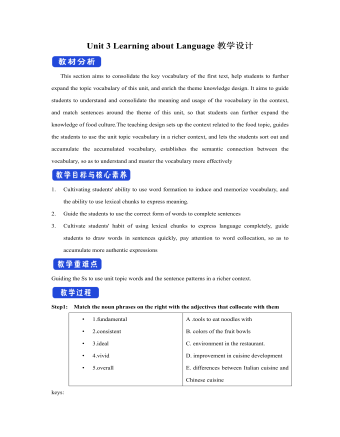
新人教版高中英语选修2Unit 3 Learning about Language教学设计
1. We'll need ten months at least to have the restaurant decorated.2.Some traditional Chinese dishes from before the Ming Dynasty are still popular today.3.My grandpa's breakfast mainly includes whole grain biscuits and a glass of milk.4.People in this area would eat nearly a kilo of cheese per week.5. We enjoyed a special dinner in a fancy restaurant where the waiters all wore attractive suits.6. He prefers this brand of coffee which, as he said, has an unusually good flavor.Key:1. at a minimum 2. prior to3. consist of4. consume5. elegant6. exceptionalStep 5:Familiarize yourself with some food idioms by matching the meaning on the right with the colored words on the left.1.Public concern for the health of farm animals has mushroomed in the UK2.Anderson may be young but he's certainly rolling to doing dough!3.George is a popular lecturer. He often peppers his speech with jokes.4.As the person to bring home the bacon, he needs to find a stable job.5 He is often regarded as a ham actor for his over emphasized facial expressions. The media reported that these companies had treated pollution as a hot potato. 6.The media reported that these companies had treated pollution as a hot potato.7.Don't worry about the test tomorrow. It's going to be a piece of cake!8. It's best to fold the swimming ring when it is as flat as a pancake.A. completely flatB. something that is very easy to do C.an issue that is hard to deal withD.to include large numbers of somethingE.to earn on e's living to support a familyF. wealthyG.to rapidly increase in numberH. an actor who performs badly, especially by over emphasizing emotions
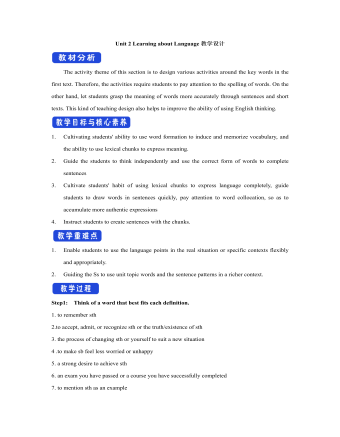
新人教版高中英语选修2Unit 2 Learning about Language教学设计
The activity theme of this section is to design various activities around the key words in the first text. Therefore, the activities require students to pay attention to the spelling of words. On the other hand, let students grasp the meaning of words more accurately through sentences and short texts. This kind of teaching design also helps to improve the ability of using English thinking.1. Cultivating students' ability to use word formation to induce and memorize vocabulary, and the ability to use lexical chunks to express meaning.2. Guide the students to think independently and use the correct form of words to complete sentences3. Cultivate students' habit of using lexical chunks to express language completely, guide students to draw words in sentences quickly, pay attention to word collocation, so as to accumulate more authentic expressions4. Instruct students to create sentences with the chunks.1. Enable students to use the language points in the real situation or specific contexts flexibly and appropriately.2. Guiding the Ss to use unit topic words and the sentence patterns in a richer context.Step1: Think of a word that best fits each definition.1. to remember sth2.to accept, admit, or recognize sth or the truth/existence of sth3. the process of changing sth or yourself to suit a new situation4 .to make sb feel less worried or unhappy5. a strong desire to achieve sth
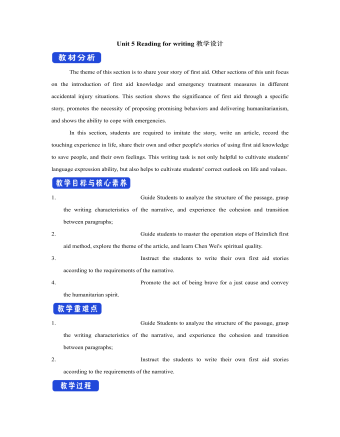
新人教版高中英语选修2Unit 5 Reading for writing教学设计
你校英语报计划出版一期急救常识专刊,现面向全校学生公开征集稿件,你有意参加。请你根据下面提示内容,用英语写一篇短文,介绍在车祸现场对伤者进行急救的方法和步骤。1.确保现场的安全;2.询问伤者,确保其呼吸正常;3.检查伤口,如流血则应采取止血措施;4.如需急救,确保其处于康复位置。注意:1.词数80左右;2.可以适当增加细节,以使行文连贯。参考词汇:康复位置 recovery positionAs we all know, having a knowledge of first aid can make a great difference in our daily life. If a traffic accident happens and someone is injured, the following steps can be used to treat the injured.In the first place, we should make sure that the accident scene is safe so that we won’t get hurt. We should ask the injured person if he is OK, and see if he is breathing. What’s more, we should check for cuts and wounds. If he is bleeding badly, it is vital that we should try to stop the bleeding by applying pressure to the injury. This is because if a person loses too much blood, he may die. If necessary, take the injured person to the hospital as soon as possible.Do remember: when giving first aid, please be sure to place the person in a recovery position.
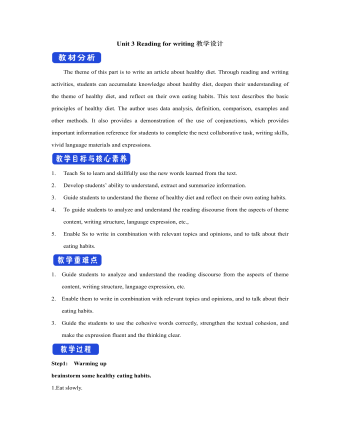
新人教版高中英语选修2Unit 3 Reading for writing教学设计
The theme of this part is to write an article about healthy diet. Through reading and writing activities, students can accumulate knowledge about healthy diet, deepen their understanding of the theme of healthy diet, and reflect on their own eating habits. This text describes the basic principles of healthy diet. The author uses data analysis, definition, comparison, examples and other methods. It also provides a demonstration of the use of conjunctions, which provides important information reference for students to complete the next collaborative task, writing skills, vivid language materials and expressions.1. Teach Ss to learn and skillfully use the new words learned from the text.2. Develop students’ ability to understand, extract and summarize information.3. Guide students to understand the theme of healthy diet and reflect on their own eating habits.4. To guide students to analyze and understand the reading discourse from the aspects of theme content, writing structure, language expression, etc., 5. Enable Ss to write in combination with relevant topics and opinions, and to talk about their eating habits.1. Guide students to analyze and understand the reading discourse from the aspects of theme content, writing structure, language expression, etc.2. Enable them to write in combination with relevant topics and opinions, and to talk about their eating habits.3. Guide the students to use the cohesive words correctly, strengthen the textual cohesion, and make the expression fluent and the thinking clear.Step1: Warming upbrainstorm some healthy eating habits.1.Eat slowly.2.Don’t eat too much fat or sugar.3.Eat healthy food.4.Have a balanced diet.Step2: Read the passage and then sum up the main idea of each paragraph.
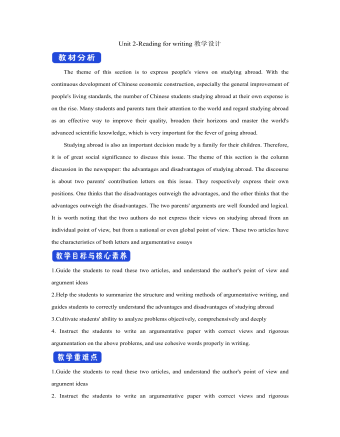
新人教版高中英语选修2Unit 2 Reading for writing教学设计
The theme of this section is to express people's views on studying abroad. With the continuous development of Chinese economic construction, especially the general improvement of people's living standards, the number of Chinese students studying abroad at their own expense is on the rise. Many students and parents turn their attention to the world and regard studying abroad as an effective way to improve their quality, broaden their horizons and master the world's advanced scientific knowledge, which is very important for the fever of going abroad. Studying abroad is also an important decision made by a family for their children. Therefore, it is of great social significance to discuss this issue. The theme of this section is the column discussion in the newspaper: the advantages and disadvantages of studying abroad. The discourse is about two parents' contribution letters on this issue. They respectively express their own positions. One thinks that the disadvantages outweigh the advantages, and the other thinks that the advantages outweigh the disadvantages. The two parents' arguments are well founded and logical. It is worth noting that the two authors do not express their views on studying abroad from an individual point of view, but from a national or even global point of view. These two articles have the characteristics of both letters and argumentative essays1.Guide the students to read these two articles, and understand the author's point of view and argument ideas2.Help the students to summarize the structure and writing methods of argumentative writing, and guides students to correctly understand the advantages and disadvantages of studying abroad3.Cultivate students' ability to analyze problems objectively, comprehensively and deeply
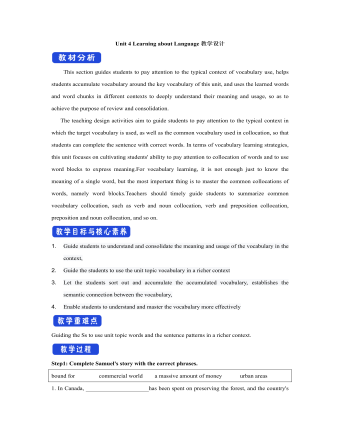
新人教版高中英语选修2Unit 4 Learning about Language教学设计
This section guides students to pay attention to the typical context of vocabulary use, helps students accumulate vocabulary around the key vocabulary of this unit, and uses the learned words and word chunks in different contexts to deeply understand their meaning and usage, so as to achieve the purpose of review and consolidation.The teaching design activities aim to guide students to pay attention to the typical context in which the target vocabulary is used, as well as the common vocabulary used in collocation, so that students can complete the sentence with correct words. In terms of vocabulary learning strategies, this unit focuses on cultivating students' ability to pay attention to collocation of words and to use word blocks to express meaning.For vocabulary learning, it is not enough just to know the meaning of a single word, but the most important thing is to master the common collocations of words, namely word blocks.Teachers should timely guide students to summarize common vocabulary collocation, such as verb and noun collocation, verb and preposition collocation, preposition and noun collocation, and so on.1. Guide students to understand and consolidate the meaning and usage of the vocabulary in the context, 2. Guide the students to use the unit topic vocabulary in a richer context3. Let the students sort out and accumulate the accumulated vocabulary, establishes the semantic connection between the vocabulary,4. Enable students to understand and master the vocabulary more effectivelyGuiding the Ss to use unit topic words and the sentence patterns in a richer context.
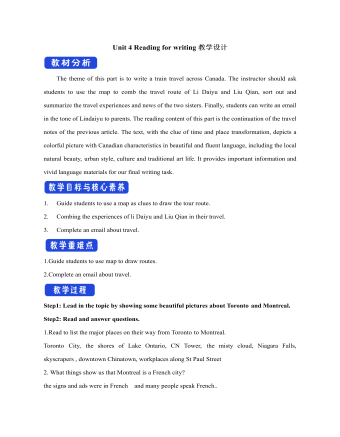
新人教版高中英语选修2Unit 4 Reading for writing教学设计
假定你是英国的Jack,打算来中国旅行,请你给你的中国笔友李华写一封信,要点如下:1.你的旅行计划:北京→泰山→杭州;2.征求建议并询问他是否愿意充当你的导游。注意:1.词数80左右(开头和结尾已给出,不计入总词数);2.可以适当增加细节,以使行文连贯。参考词汇:故宫 the Forbidden City;泰山 Mount TaiDear Li Hua,I'm glad to tell you that 'm going to visit China.First,I am planning to visit Beijing,the capitalof China,where I am looking forward to enjoying the Great Wall,the Forbidden City and somebeautiful parks.Then I intend to go to visit Mount Tai in Shandong Province.I've heard that it is one ofthe most famous mountains in China and I can't wait to enjoy the amazing sunrise there.After that,I amalso going to Hangzhou.It is said that it is a beautiful modern city with breathtaking natural sights,among which the West Lake is a well- known tourist attraction.What do you think of my travel plan? Will you act as my guide? Hope to hear from you soon.

新人教版高中英语选修2Unit 4 Using langauge-Listening教学设计
The theme of the listening section is " talking about scenery and culture along a journey."The part is designed to further lead the students to understand Canadian natural geography and social environment, and integrated into the cultural contrast by mentioning the long train journey from Beijing to Moscow routes. On this basis, the part activates students related travel experience, lets the student serial dialogue, guides the student to explore further the pleasure and meaning of the long journey, and Chinese and foreign cultural comparison.The part also provides a framework for the continuation of the dialogue, which is designed to provide a framework for students to successfully complete their oral expressions, and to incorporate an important trading strategy to end the dialogue naturally.1. Help students to understand and master some common English idioms in the context, and experience the expression effect of English idioms.2. Guide the students to understand the identity of different people in the listening context, and finish the dialogue according to their own experience.3. Instruct the students to use appropriate language to express surprise and curiosity about space and place in the dialogue, and master the oral strategy of ending the dialogue naturally.1. Instruct students to grasp the key information and important details of the dialogue.2. Instruct students to conduct a similar talk on the relevant topic.

新人教版高中英语选修2Unit 5 Learning about Language教学设计
The purpose of this section of vocabulary exercises is to consolidate the key words in the first part of the reading text, let the students write the words according to the English definition, and focus on the detection of the meaning and spelling of the new words. The teaching design includes use English definition to explain words, which is conducive to improving students' interest in vocabulary learning, cultivating their sense of English language and thinking in English, and making students willing to use this method to better grasp the meaning of words, expand their vocabulary, and improve their ability of vocabulary application. Besides, the design offers more context including sentences and short passage for students to practice words flexibly.1. Guide students to understand and consolidate the meaning and usage of the vocabulary in the context, 2. Guide the students to use the unit topic vocabulary in a richer context3. Let the students sort out and accumulate the accumulated vocabulary, establishes the semantic connection between the vocabulary,4. Enable students to understand and master the vocabulary more effectivelyGuiding the Ss to use unit topic words and the sentence patterns in a richer context.Step1: Read the passage about chemical burns and fill in the blanks with the correct forms of the words in the box.
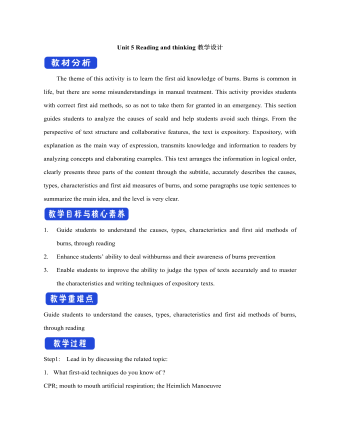
新人教版高中英语选修2Unit 5 Reading and thinking教学设计
The theme of this activity is to learn the first aid knowledge of burns. Burns is common in life, but there are some misunderstandings in manual treatment. This activity provides students with correct first aid methods, so as not to take them for granted in an emergency. This section guides students to analyze the causes of scald and help students avoid such things. From the perspective of text structure and collaborative features, the text is expository. Expository, with explanation as the main way of expression, transmits knowledge and information to readers by analyzing concepts and elaborating examples. This text arranges the information in logical order, clearly presents three parts of the content through the subtitle, accurately describes the causes, types, characteristics and first aid measures of burns, and some paragraphs use topic sentences to summarize the main idea, and the level is very clear.1. Guide students to understand the causes, types, characteristics and first aid methods of burns, through reading2. Enhance students’ ability to deal withburnss and their awareness of burns prevention3. Enable students to improve the ability to judge the types of texts accurately and to master the characteristics and writing techniques of expository texts.Guide students to understand the causes, types, characteristics and first aid methods of burns, through readingStep1: Lead in by discussing the related topic:1. What first-aid techniques do you know of ?CPR; mouth to mouth artificial respiration; the Heimlich Manoeuvre

新人教版高中英语选修2Unit 5 Using langauge-Listening教学设计
The theme of this section is to learn how to make emergency calls. Students should learn how to make emergency calls not only in China, but also in foreign countries in English, so that they can be prepared for future situations outside the home.The emergency telephone number is a vital hotline, which should be the most clear, rapid and effective communication with the acute operator.This section helps students to understand the emergency calls in some countries and the precautions for making emergency calls. Through the study of this section, students can accumulate common expressions and sentence patterns in this context. 1.Help students accumulate emergency telephone numbers in different countries and learn more about first aid2.Guide the students to understand the contents and instructions of the telephone, grasp the characteristics of the emergency telephone and the requirements of the emergency telephone.3.Guide students to understand the first aid instructions of the operators.4.Enable Ss to make simulated emergency calls with their partners in the language they have learned1. Instruct students to grasp the key information and important details of the dialogue.2. Instruct students to conduct a similar talk on the relevant topic.Step1:Look and discuss:Match the pictures below to the medical emergencies, and then discuss the questions in groups.

人教版高中政治必修1第一课神奇的货币教案
1、外汇与外币的关系:(1)外汇包括外币,但外汇不等于就是外币。外币是指外国的货币,包括外国的纸币、铸币;外汇通常是以外国货币表示的用于国际间结算的支付手段,具体包括外币、外币有价证券、外币支付凭证等。(2)外币属于外汇的范围,但不能把二者等同起来。通常情况下,只有可以自由兑换的外币才是外汇,因为外汇的实质是国际支付手段,如果某种货币不能自由兑换,它就不能成为国际支付手段。外汇执行的 主要是货币的支付手段的职能。(3)持有外汇意味着对外汇发行国拥有债权。持有外汇过多,一方面意味着国际支付能力强和有可能对外汇发行国施加影响;另一方面则意味着大量该由本国享受的资源,被借给外国利用,并要承担外汇贬值的风险。2、关于币值变化的分析:(1)对货币升值的具体分析:一个国家的货币升值(上浮)后,同量的这种货币能比以前换 取更多的他国货币,买到更多的他国商品。

人教版高中政治必修4第九课唯物辩证法的实质和核心精品教案
a矛盾的同一性是矛盾双方相互吸引、相互联结的属性和趋势。它有两方面的含义:一是矛盾双方相互依赖,一方的存在以另一方的存在为前提,双方共处于一个统一体中;同一事物都有对立面和统一面两个方面,一方的存在以另一方为条件,彼此谁都离不开谁(形影想随、一个巴掌拍不响、不是冤家不聚头)。【举例】P67漫画:他敢剪吗?悬挂在山崖上的两个人构成一种动态的平衡。【举例】磁铁(S极和N极);没有上就没有下、没有香就没有臭、没有福就无所谓祸;【举例】父子关系(父亲之所以是父亲,因为有儿子,儿子之所以是儿子,因为有父亲);师生关系;二是矛盾双方相互贯通,即相互渗透、相互包含,在一定条件下可以相互转化。 【相关衔接】P68生物变性现象,雌雄转化现象【举例】生产与消费具有直接统一性
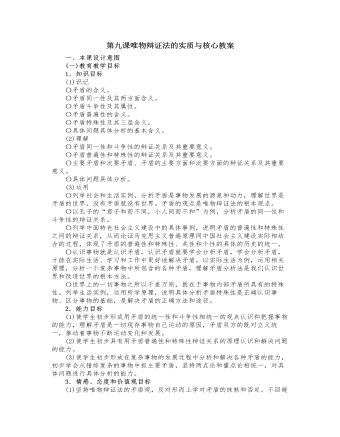
人教版高中政治必修4第九课唯物辩证法的实质与核心教案
探究活动8(教材第72页):“结合生活事例,谈谈你在面对复杂事物时是如何分析和解决矛盾的?”这一探究活动是在学生还不了解主次矛盾的原理时,让他们回忆自己在生活中有没有遇到过面对许多矛盾时是如何解决的经历。比如,每天面对很多作业,先做哪门课作业后做哪门作业,你是如何考虑的?在学校面对学习、体育运动和社会工作,你是怎么安排的?在生活中,你遇到这样的情况都是怎样解决的?通过探究活动,使学生弄清主次矛盾的原理,学会用矛盾分析法分析问题。探究活动9(教材第73页):“你在生活中是如何分析具体问题的?”这一探究活动,强调的是“你”在生活中是如何运用分析法分析具体问题的,要紧紧围绕学生这一中心,首先强调具体问题具体分析的方法非常重要,这是马克思主义的一个原则,是马克思主义的活的灵魂。引导学生主动运用这种分析方法分析看待自己,分析看待社会。可以组织学生进行讨论、交流,还可以让学生撰写小论文,写出自己运用这种分析方法分析了哪些具体问题,有哪些感受。
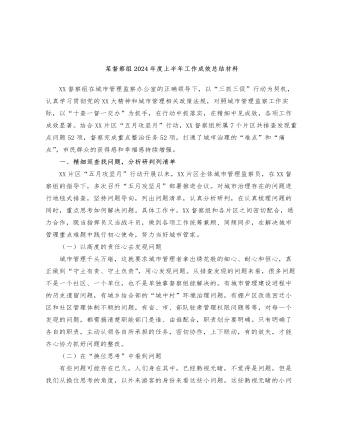
某督察组2024年度上半年工作成效总结材料
(二)根据实际情况有效解决问题针对排查出的问题,制定切实可行的整治方案,督促相关社区、主管部门、城市管理综合行政执法局等责任单位,对问题清单进行认领,督促整改,对账销号。“即查即改”的问题,现场进行交办,现场解决。对一时难以整改的倒排工期,列出时间表,逐步整改到位。确保工作传达到社区、落实到一线、行动到社区楼院。并对工作不力的单位进行通报。如xx小学北面,xx小区对面,原林业局果园,因存在土地属性和产权纠纷,长期闲置,成了乱停乱放,流动摊贩聚集的场所,垃圾遍地,遇到刮大风,沙尘遍野,对面是学校和居民区,严重的影响到了学校和居民的日常生活,群众意见很大。XX督察组多次组织自然资源局、交警队、环保局、环卫中心、金水湾物业、XX社区和土地老板召开联席会议,都没有把问题解决掉。“五月攻坚月”开展以来,XX督察组再次召集相关部门召开联席会议,经过多方协商,最终筹集资金3000元,清理里面的摊贩和常年堆积的垃圾,购买250米人工仿真草坪,对闲置空地进行了围护,彻底解决了脏乱差问题,得到了周围群众和师生家长的一致好评。
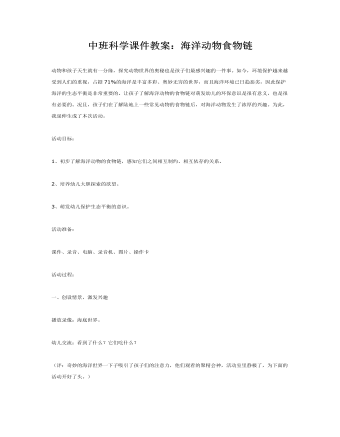
中班科学课件教案:海洋动物食物链
活动目标: 1、初步了解海洋动物的食物链,感知它们之间相互制约、相互依存的关系。 2、培养幼儿大胆探索的欲望。 3、萌发幼儿保护生态平衡的意识。 活动准备: 课件、录音、电脑、录音机、图片、操作卡活动过程: 一、创设情景,激发兴趣 播放录像:海底世界。 幼儿交流:看到了什么?它们吃什么? (评:奇妙的海洋世界一下子吸引了孩子们的注意力,他们观看的聚精会神,活动室里静极了,为下面的活动开好了头。)
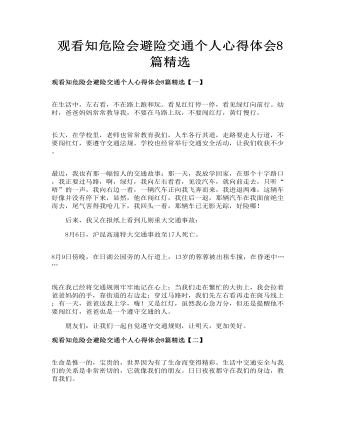
观看知危险会避险交通个人心得体会8篇精选
生命是惟一的,宝贵的,世界因为有了生命而变得精彩。生活中交通安全与我们的关系是非常密切的,它就像我们的朋友。日日夜夜都守在我们的身边,教育我们。 遵守交通规则人人皆知,可偏偏有一部分人充耳不闻,视而不见。把遵守交通规则当成耳旁风,从而导致一起又一起的交通事故带走了许多人的生命,让人们认识到了交通事故的可怕。就拿最近发生的一起交通事故来说吧,他们几个都是风华正茂的青少年,由于他们不遵守交通规则,一刹那间,死神就夺走了他们的生命,酿成了血的教训。
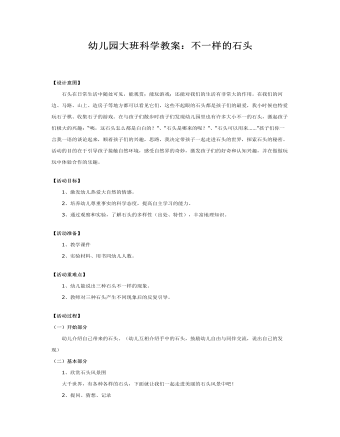
大班科学教案:不一样的石头
【活动目标】1、激发幼儿热爱大自然的情感。2、培养幼儿尊重事实的科学态度,提高自主学习的能力。3、通过观察和实验,了解石头的多样性(出处、特性),丰富地理知识。【活动准备】1、教学课件2、实验材料、用书同幼儿人数。【活动重难点】1、幼儿能说出三种石头不一样的现象。2、教师对三种石头产生不同现象后的反复引导。【活动过程】(一)开始部分 幼儿介绍自己带来的石头。(幼儿互相介绍手中的石头,鼓励幼儿自由与同伴交流,说出自己的发现)(二)基本部分1、欣赏石头风景图 大千世界,有各种各样的石头,下面就让我们一起走进美丽的石头风景中吧!2、提问、猜想、记录 (1)提问:在大自然中,石头成为美丽的风景,石头又分为哪几种,每种石头又叫什么? (幼儿讨论)并且介绍石头的正确名称观看课件,了解石头名称。 (2)猜想:①你觉得三种石头能够漂浮在水面的是哪一种?②你觉得三种石头能写字的是哪一种?③你觉得三种石头摸上去最光华的哪一种? (3)纪录: 幼儿把猜想记录在《幼儿用书》的猜想表格中。3、幼儿动手实验,感知石头的特性, (1)把石灰石、鹅卵石和火山石放在手中,感受那个摸起来最光滑。 (2)用石灰石、鹅卵石和火山石在黑卡纸画画,哪个可以画出来。 (3)把石灰石、鹅卵石和火山石放进水中,会发现哪个能浮起来。 (4)把自己发现记录在《幼儿用书》的发现表格中(教师帮助幼儿认读书中相应的正确答案)。
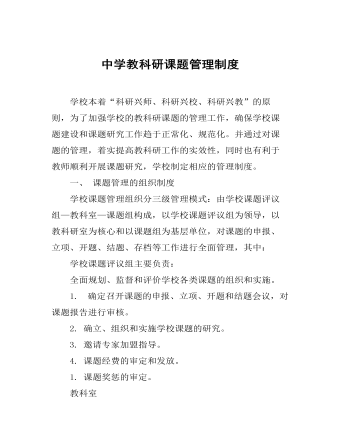
中学教科研课题管理制度
一、 课题管理的组织制度 学校课题管理组织分三级管理模式:由学校课题评议组—教科室—课题组构成,以学校课题评议组为领导,以教科研室为核心和以课题组为基层单位,对课题的申报、立项、开题、结题、存档等工作进行全面管理,其中: 学校课题评议组主要负责: 全面规划、监督和评价学校各类课题的组织和实施。 1. 确定召开课题的申报、立项、开题和结题会议,对课题报告进行审核。 2. 确立、组织和实施学校课题的研究。 3. 邀请专家加盟指导。 4. 课题经费的审定和发放。 1. 课题奖惩的审定。 教科室 教科研中心主要负责: 1. 向全校传达每年的课题规划。 2. 组织课题的申报、立项、开题、阶段总结和结题工作。 3. 参与和组织学校课题研究的实施工作。 4. 组织参与课题研究的教师进行理论学习、座谈、思想交流、研讨、外出培训和观摩的活动。 5. 组织开展关于课题研究的讲座。 6. 联络和组织课题会议的召开工作。 7. 对学校和教师的课题的整个过程和所有内容进行备案。。 课题组主要负责: 1. 组织教师参与课题的研究。 2. 向本组教师传达每年的课题规划。 3. 督促教师及时写出阶段报告和结题报告。 4. 及时向教科研室反馈教师在课题研究中遇到的问题,以便于及时得到解决,使每位教师能按时完成课题研究。
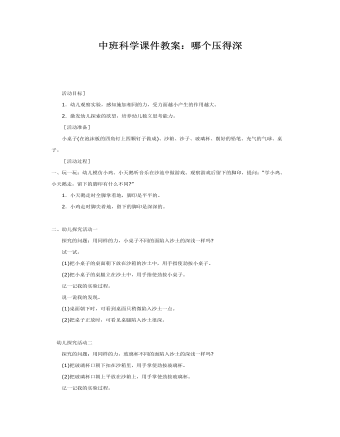
中班科学课件教案:哪个压得深
2.激发幼儿探索的欲望,培养幼儿独立思考能力。 [活动准备] 小桌子(在泡沫板的四角钉上四颗钉子做成)、沙箱、沙子、玻璃杯、削好的铅笔、充气的气球、桌子。 [活动过程]一、玩一玩:幼儿模仿小鸡、小天鹅听音乐在沙池中做游戏。观察游戏后留下的脚印,提问:“学小鸡、小天鹅走,留下的脚印有什么不同?”1.小天鹅走时全脚掌着地,脚印是平平的。2.小鸡走时脚尖着地,留下的脚印是深深的。二、幼儿探究活动一 探究的问题:用同样的力,小桌子不同的面陷入沙土的深浅一样吗? 试一试。(1)把小桌子的桌面朝下放在沙箱的沙土中,用手指使劲按小桌子。(2)把小桌子的桌腿立在沙土中,用手指使劲按小桌子。 记一记我的实验过程。 说一说我的发现。(1)桌面朝下时,可看到桌面只稍微陷入沙土一点。(2)把桌子正放时,可看见桌腿陷入沙土很深。


